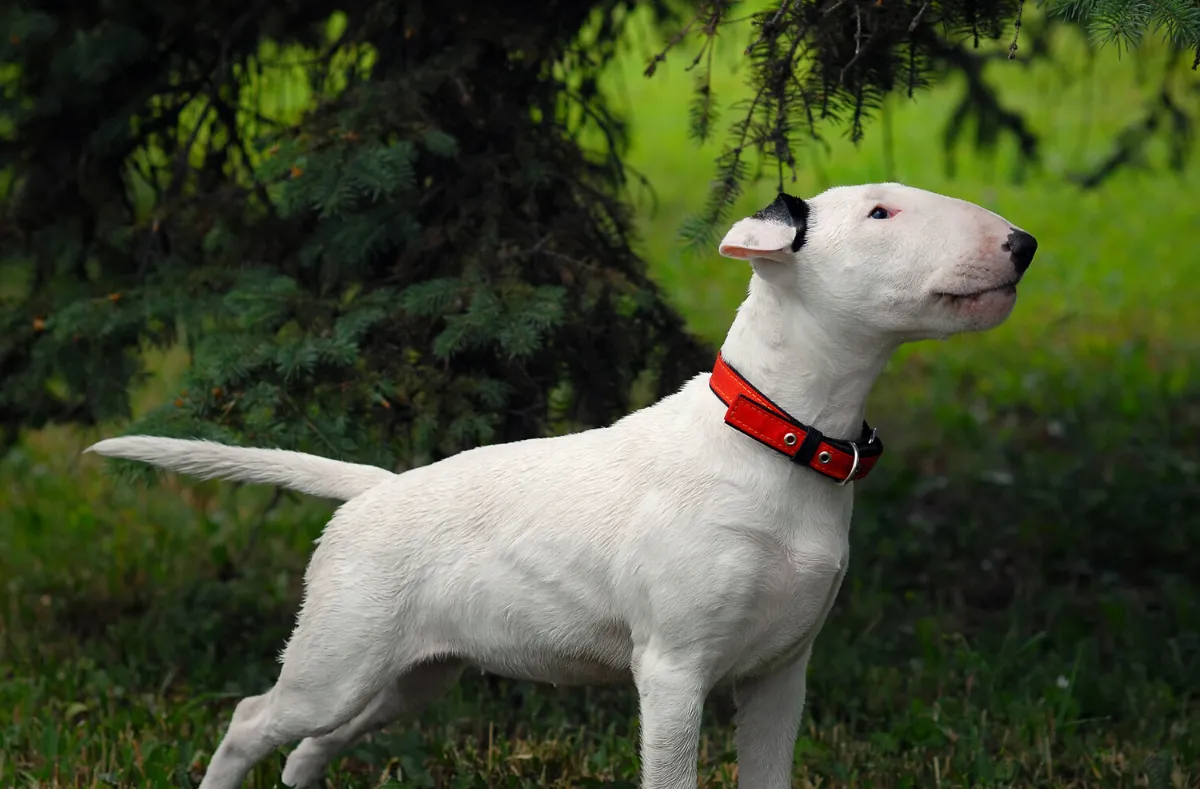Bull Terriers are known for their unique appearance and playful personalities. However, their distinctive physical features can also lead to health problems, including breathing difficulties. Many people wonder if Bull Terriers are prone to breathing problems and if there are any measures that can be taken to prevent or treat these issues.

Bull Terriers have a unique head shape that sets them apart from other breeds. Their egg-shaped heads and short snouts can lead to respiratory problems, including snoring, wheezing, and difficulty breathing. These issues are often caused by a condition called brachycephalic obstructive airway syndrome (BOAS), which affects many breeds with short snouts. While not all Bull Terriers will develop breathing problems, it is important for owners to be aware of the risks and take steps to prevent or manage these issues if they arise.
In this article, we will explore the topic of Bull Terriers and breathing problems in more detail. We will discuss the causes and symptoms of respiratory issues in Bull Terriers, as well as the treatment options available. Whether you are a current or prospective Bull Terrier owner, understanding the potential health risks associated with this breed is essential for providing the best possible care for your furry friend.

Bull Terrier Breathing Basics
Bull Terriers are a unique breed with a distinctive egg-shaped head and a muscular build. However, their unique physical features can make them prone to certain health issues, including respiratory problems. In this section, we will explore the anatomy of Bull Terrier airways and common respiratory issues that affect this breed.
Anatomy of Bull Terrier Airways
Bull Terriers have a unique respiratory system that differs from other dog breeds. Their short, broad skull and flattened face can cause respiratory issues, such as brachycephalic airway syndrome. This syndrome is characterized by narrow nostrils, elongated soft palate, and a small trachea, which can cause breathing difficulties.
The larynx, which is located at the top of the trachea, is another important part of the Bull Terrier's respiratory system. It helps regulate airflow and protect the lungs from foreign objects. However, some Bull Terriers may have a weak or malformed larynx, which can lead to breathing problems.
Common Respiratory Issues in Bull Terriers
Bull Terriers are prone to several respiratory issues, including:
- Brachycephalic airway syndrome: As mentioned earlier, this syndrome is caused by the breed's unique physical features and can cause breathing difficulties, especially during exercise or in hot weather.
- Tracheal collapse: This condition occurs when the trachea loses its shape and becomes narrow, making it difficult for the Bull Terrier to breathe.
- Allergies: Bull Terriers can develop allergies to various environmental factors, such as pollen, dust, or cigarette smoke, which can cause respiratory problems.
- Infections: Respiratory infections, such as kennel cough, can cause inflammation and narrowing of the airways, leading to breathing difficulties.
It is important to note that not all Bull Terriers will experience respiratory problems, and some may have a more severe condition than others. However, it is essential to be aware of the breed's unique respiratory system and potential health issues to provide proper care and treatment.
Hereditary Health Concerns
Bull Terriers are generally healthy dogs, but like all breeds, they are prone to certain health issues. Some of these issues can be inherited from their parents and can be passed on to future generations. It's important for breeders and owners to be aware of these hereditary health concerns and take appropriate measures to prevent or manage them.
Inherited Respiratory Conditions
Bull Terriers are brachycephalic dogs, which means they have a shortened skull and flat face. This can lead to breathing difficulties, especially during exercise or in hot weather. Some Bull Terriers may also develop other respiratory conditions, such as laryngeal paralysis or tracheal collapse.
These conditions can be inherited, so it's important to choose a breeder who screens their dogs for respiratory issues and breeds only healthy individuals. Owners should also be aware of the signs of respiratory distress in their Bull Terrier and seek veterinary care if necessary.
Genetic Testing and Breeding
To prevent the spread of hereditary health concerns, breeders can use genetic testing to identify carriers of certain conditions and avoid breeding them. This can help reduce the incidence of inherited health issues in future generations.
Breeders should also ensure that they are breeding dogs with good overall health and temperament, not just focusing on physical appearance. This can help reduce the risk of hereditary health concerns and produce healthier, happier Bull Terriers.
Overall, Bull Terriers can be prone to certain hereditary health concerns, but with proper breeding and management, these issues can be minimized. Owners should work with their breeders and veterinarians to ensure their Bull Terrier stays healthy and happy throughout their life.
Specific Conditions Affecting Bull Terriers
Bull Terriers are generally healthy dogs, but like all breeds, they can be prone to certain health conditions. Here are some of the specific conditions that affect Bull Terriers:
Brachycephalic Airway Syndrome
Bull Terriers, like other brachycephalic (short-nosed) breeds, can suffer from Brachycephalic Airway Syndrome (BAS). This condition is caused by the breed's facial structure, which can cause breathing difficulties. Symptoms of BAS can include snoring, wheezing, and difficulty breathing, especially during exercise or in hot weather. Surgery may be necessary in severe cases to correct the underlying anatomical abnormalities.
Laryngeal Paralysis
Laryngeal paralysis is a condition that affects the muscles that control the opening and closing of the larynx (voice box). It can cause difficulty breathing, especially during exercise or in hot weather. Bull Terriers may be more prone to this condition than other breeds. Treatment may include surgery to improve airflow and reduce the risk of aspiration pneumonia.
Other Hereditary Diseases
Bull Terriers can also be prone to other hereditary diseases, including congenital deafness and hereditary nephritis (kidney disease). Regular veterinary check-ups and genetic testing can help identify these conditions early, allowing for prompt treatment and management.
Overall, Bull Terriers are generally healthy dogs, but it is important for owners to be aware of these potential health concerns and to seek veterinary care if they notice any signs of illness or discomfort in their pets.

Clinical Signs and Diagnosis
Breathing difficulties in Bull Terriers can be a serious health concern, and it is important to recognize the clinical signs and seek veterinary care promptly.
Recognizing Breathing Difficulties
Bull Terriers with breathing problems may exhibit a range of clinical signs, including:
- Noisy breathing
- Shortness of breath
- Rapid breathing
- Wheezing
- Gagging or choking
- Coughing
- Blue or pale gums
- Exercise intolerance
These clinical signs may be more pronounced during exercise or excitement, and may worsen over time.
Veterinary Examination and Tests
If a Bull Terrier is exhibiting clinical signs of breathing difficulties, a veterinary examination is necessary to determine the underlying cause. The vet will perform a thorough physical examination, including listening to the dog's breathing and heart sounds.
Additional tests that may be performed include:
- Blood work to evaluate oxygen levels and organ function
- Chest X-rays to evaluate the lungs and heart
- Bronchoscopy or endoscopy to evaluate the airways
- BAER (brainstem auditory evoked response) test to evaluate hearing
Based on the results of these tests, the vet will be able to diagnose the underlying cause of the breathing difficulties and recommend an appropriate treatment plan.
In conclusion, recognizing the clinical signs of breathing difficulties in Bull Terriers and seeking prompt veterinary care is crucial for the health and well-being of these beloved pets.
Treatment and Management
Surgical Interventions
In severe cases of breathing problems in Bull Terriers, surgical interventions may be necessary. These interventions can include soft palate resection, stenotic nares correction, and even tracheal surgery. Soft palate resection involves removing a portion of the soft palate to increase the size of the airway. Stenotic nares correction involves surgically widening the nostrils to improve airflow. Tracheal surgery involves placing a stent or removing a portion of the trachea to alleviate compression and improve breathing. It is important to note that surgical interventions are not always necessary and should only be considered under the guidance of a veterinarian.
Non-Surgical Management
Non-surgical management of breathing problems in Bull Terriers can include oxygen therapy, weight loss, and diet modifications. Oxygen therapy can be used to provide supplemental oxygen to dogs who are experiencing respiratory distress. Weight loss can help alleviate breathing problems by reducing the amount of pressure on the airway. Diet modifications can also be helpful in managing breathing problems, as certain foods can exacerbate respiratory issues.
Lifestyle and Environmental Changes
Lifestyle and environmental changes can also be beneficial in managing breathing problems in Bull Terriers. Exercise intolerance should be monitored and exercise should be limited to prevent respiratory distress. Environmental factors such as smoke, dust, and pollen should also be minimized to reduce the risk of respiratory irritation. Owners should also ensure that their Bull Terrier has access to clean, fresh air and a comfortable living environment to improve their quality of life.
Overall, the treatment and management of breathing problems in Bull Terriers should be approached on an individual basis and under the guidance of a veterinarian. With proper care and management, Bull Terriers with breathing problems can lead happy and healthy lives.
Living with a Bull Terrier
Bull Terriers are a unique and lovable breed, but they do require some special care to keep them healthy and happy. Here are some tips for living with a Bull Terrier.
Diet and Nutrition
A healthy diet is crucial for Bull Terriers, as they are prone to obesity and other health problems. It is important to feed them a balanced diet that is appropriate for their age, size, and activity level. Consult with a veterinarian to determine the best diet for your Bull Terrier.
Avoid feeding your Bull Terrier table scraps or human food, as this can lead to weight gain and other health issues. Stick to high-quality dog food that is rich in protein and other essential nutrients.
Exercise and Socialization
Bull Terriers are energetic dogs that require plenty of exercise and socialization to stay healthy and happy. Regular walks and playtime are essential for their physical and mental well-being. They also benefit from socializing with other dogs and people.
It is important to supervise your Bull Terrier during playtime, as they can be prone to rough play and may accidentally injure themselves or others. A well-socialized and well-exercised Bull Terrier will be happier, healthier, and more well-behaved.

Regular Health Check-Ups
Regular visits to the veterinarian are essential for keeping your Bull Terrier healthy. They should receive regular check-ups, vaccinations, and preventative care to prevent health problems before they occur.
Bull Terriers are prone to certain health issues, such as breathing problems, skin allergies, and eye problems. Regular check-ups can help catch these issues early and prevent them from becoming more serious.
In conclusion, Bull Terriers require a balanced diet, plenty of exercise and socialization, and regular visits to the veterinarian to stay healthy and happy. With proper care, they can live long and fulfilling lives.
Breeding and Genetics
Responsible Breeding Practices
Responsible breeding practices can help reduce the risk of bull terriers developing breathing problems. Breeders should carefully select breeding pairs and perform health screenings to identify any potential genetic risks. They should also avoid breeding dogs with known respiratory problems or those that are closely related to dogs with respiratory issues.
Additionally, breeders should prioritize the health and well-being of the puppies over profit. They should provide proper care and socialization to the puppies during the critical early weeks of life. This can help reduce the likelihood of respiratory problems later in life.
Understanding Genetic Risks
Bull terriers are prone to several genetic mutations that can increase the risk of breathing problems. These include:
- Primary ciliary dyskinesia (PCD): a genetic disorder that affects the cilia, which are microscopic hair-like structures that line the respiratory tract. PCD can cause chronic respiratory infections, bronchitis, and pneumonia.
- Brachycephalic obstructive airway syndrome (BOAS): a condition that affects dogs with short snouts, such as bull terriers. BOAS can cause breathing difficulties, especially during exercise or in warm weather.
- Pulmonic stenosis: a congenital heart defect that can cause breathing difficulties and other symptoms.
Breeders should be aware of these genetic risks and take steps to minimize the likelihood of passing these mutations on to future generations. This may involve genetic testing of breeding pairs, as well as careful selection of breeding partners to avoid dogs with known respiratory problems or genetic mutations.
In conclusion, responsible breeding practices and a thorough understanding of genetic risks can help reduce the likelihood of bull terriers developing breathing problems. Breeders should prioritize the health and well-being of their dogs and puppies, and take steps to minimize the risk of passing on genetic mutations that can lead to respiratory issues.
Bull Terrier Health and Wellness
Bull Terriers are generally healthy dogs with a life expectancy of 10-12 years. However, like all breeds, they are prone to certain health issues. It is important for owners to be aware of these potential problems and take preventative measures to keep their pets healthy.
Common Health Problems in Bull Terriers
One of the most common health problems in Bull Terriers is breathing difficulties. This is due to their short snouts and narrow airways, which can lead to snoring, wheezing, and difficulty breathing. Other common health issues in Bull Terriers include skin problems, allergies, kidney failure, and heart murmurs.
Skin problems in Bull Terriers can range from mild irritation to serious infections. Regular grooming, including bathing and brushing, can help prevent skin issues. Allergies can also cause skin problems, as well as other symptoms such as itching, sneezing, and coughing.
Kidney failure is a serious health issue that can affect Bull Terriers. Symptoms may include increased thirst and urination, vomiting, and weight loss. Regular check-ups with a veterinarian can help detect kidney problems early and prevent further damage.
Preventative Care and Regular Maintenance
Preventative care and regular maintenance are key to keeping Bull Terriers healthy. This includes regular check-ups with a veterinarian, vaccinations, and preventative treatments for parasites such as fleas and ticks.
Bull Terriers also require regular grooming to keep their coats healthy and free from mats and tangles. This includes regular brushing, bathing, and nail trimming. Regular exercise and a healthy diet are also important for maintaining a Bull Terrier's overall health and wellness.

In summary, Bull Terriers are generally healthy dogs but are prone to certain health issues. Owners can take preventative measures to keep their pets healthy, including regular check-ups, vaccinations, grooming, and exercise. By being aware of potential health problems and taking preventative measures, owners can help ensure their Bull Terriers live long and healthy lives.
Conclusion
In conclusion, while Bull Terriers may be predisposed to breathing problems due to their anatomy, proactive care, responsible breeding, and lifestyle adjustments can significantly enhance their quality of life. By understanding and addressing potential issues early on, Bull Terrier owners can ensure their beloved companions lead happy, healthy lives.
FAQs
- 1. Can all Bull Terriers experience breathing problems?
- While not all Bull Terriers will face respiratory issues, the breed's anatomy makes them more susceptible. Responsible breeding and proactive care can mitigate these risks.
- 2. What should I do if I notice signs of breathing difficulties in my Bull Terrier?
- Immediate veterinary attention is crucial. Early intervention can prevent the progression of respiratory problems and improve the dog's overall prognosis.
- 3. How can I create a conducive living environment for my Bull Terrier?
- Maintain a comfortable temperature, ensure good ventilation, and minimize exposure to smoke or pollutants. These factors contribute to a healthier respiratory system.
- 4. Are there specific exercises to improve my Bull Terrier's breathing?
- Consult with a veterinarian for tailored breathing exercises suitable for your Bull Terrier's individual needs. Regular, moderate exercise is generally beneficial.
- 5. Is it possible to prevent breathing problems in Bull Terriers through diet?
- A well-balanced diet is crucial. Work with your veterinarian to determine the best nutritional plan, considering the breed's unique health requirements.




